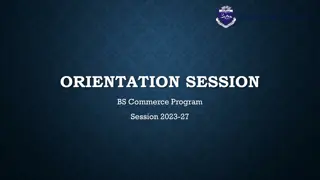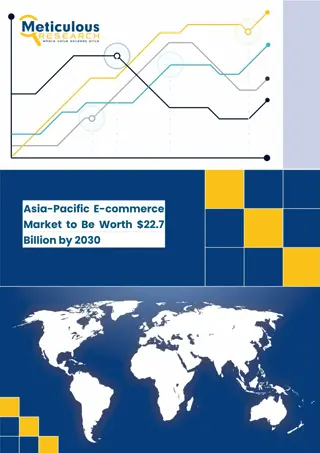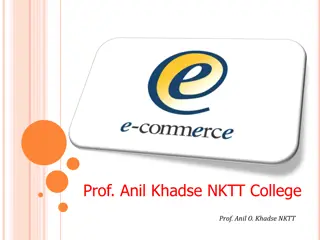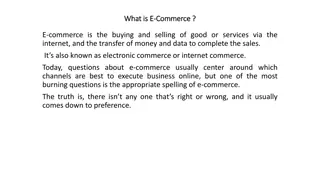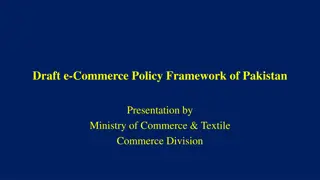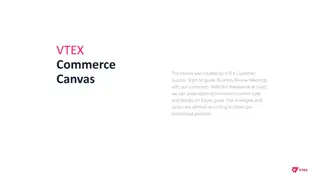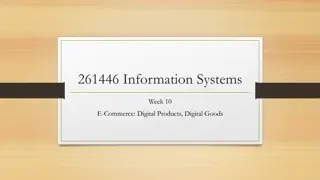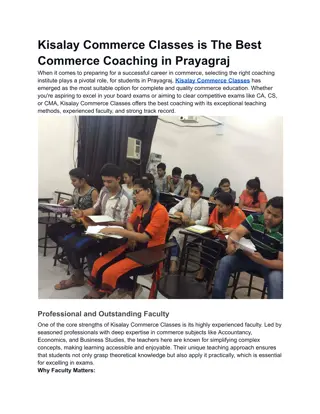E-commerce Website Profitability Analysis in France
Evolution of e-commerce website profitability in France is examined, highlighting factors impacting profitability, levers used to monetize website audiences, and the overall profitability landscape. The study reveals insights into the key questions surrounding the profitability of e-commerce websites, such as their break-even points, trends in profitability growth, and the proportion of profitable websites. With data from years 2011 to 2015, including insights into leading websites and different business sizes, the study sheds light on the profitability status of e-commerce ventures in the French market.
Download Presentation

Please find below an Image/Link to download the presentation.
The content on the website is provided AS IS for your information and personal use only. It may not be sold, licensed, or shared on other websites without obtaining consent from the author. Download presentation by click this link. If you encounter any issues during the download, it is possible that the publisher has removed the file from their server.
E N D
Presentation Transcript
E-commerce websites: Profitability levers
Foreword Evolution of the websites that have reached their break even point The share of profitable websites decreases since 2011..but stabilizes since 2013. 80% 70% 69% 60% 2011 2012 2013 2014 Evolution of the websites that have increased their profitability For 4 years, it is rather the leading websites that manage to increase profitability (vs all websites). Leading websites All 83% 64% 64% 59% 50% 49% 35% 25% 2011 2012 2013 2014 3 Sources : tude CCM Benchmark 2012, 2013, 2014 et tude TNS Sofres 2015 pour Webloyalty
Study Methodology Sample Type of collection 105 e-commerce decision-makers Turnover Interviews made by phone Small ( <1 M ) Fashion Tourism Home equipment Culture, high tech, Medium (between 1 and 10 M ) Big (between 10 and 50 M ) Autre Field time 18% 22% 23% 37% From 03/29/2016 to 04/13/2016 4% 18% 13% 38% 27% Etude TNS Sofres pour Webloyalty - 2016 5
Key questions of the study Profitability of e- commerce websites in France What are the key evolution factors of profitability ? What are the levers used to monetize websites audience ? Are e-commerce websites profitable ? 6
Are e-commerce websites profitable ? 7 websites out of 10 have reached their break even point in 2015, almost as in 2014. 70% Of profitables websites 71% 10% Leading websites 16% (69% in 2014 ) 89% Big websites 14% 87% Medium websites 45% Small websites 60% 81% Click & Mortar Yes since 2015 Yes for several years No, it's the objective of the year to come Not yet 65% Pure Players Etude TNS Sofres pour Webloyalty - 2016 8
Is the profitability of websites increasing ? Nearly half of the websites have improved their profitability in 2015, while just over a quarter saw their profitability decline, a stable trend vs. 2014. The proportion of websites with profitability in strong decline has still quadrupled. Profitability Evolution Decrease (3% in 2014) 28% Increase strongly 4% (24% en 2014) 19% 12% Increase a little Stay stable Increase 16% Decrease a little 48% 29% Decline strongly 20% (49% in 2014) NSP Etude TNS Sofres pour Webloyalty - 2016
Is the profitability of websites increasing ? The profitability of leading websites tended to stagnate in 2015, while that of large sites progressed. Medium size websites are struggling to stabilize. Profitability Evolution according to size and type of websites Increase Stay stable Decrease NSP Leading websites 21% 50% 21% 7% 0% Big websites 63% 11% 26% Medium websites 62% 0% 37% 0% 6% Small websites 44% 23% 27% Click & Mortar 46% 18% 32% 3% 3% Pure Players 51% 21% 25% Etude TNS Sofres pour Webloyalty - 2016 10
Factors of profitability evolution Customer loyalty is the most important factor in the evolution of the profitability of the websites after the turnover. Factors of increase / Decrease of profitability Decreased profitability Increased profitability 87% 66% L' volution du chiffre d'affaires, des ventes L' volution du chiffre d'affaires, des ventes Turnover evolution Customers loyalty 75% 51% (29% in 2014 ) La fid lit des clients La fid lit des clients 70% 36% La marge commerciale La marge commerciale Mark up Les taux de transformation Conversion rate 68% 38% Les taux de transformation 57% 25% La part des produits forte marge dans le chiffre d'affaires La part des produits forte marge dans le chiffre d'affaires Share of high-margin products in turnover 51% 38% Exploitation costs Les co ts d'exploitation Les co ts d'exploitation 28% 21% Des investissements r cents r alis s Recent investments made Des investissements r cents r alis s 26% 32% Les co ts de recrutements de clients Customers recruitment costs Les co ts de recrutements de clients 10% 28% Etude TNS Sofres pour Webloyalty - 2016 Les recettes des activit s hors distribution Les recettes des activit s hors distribution Revenues excluding distribution activities 12 Etude TNS Sofres pour Webloyalty - 2016
Growth drivers To achieve their growth objectives, the sites will rely first on social networks, much more than in 2014, as well as diversifying and customizing their offer. Future growth drivers 81% (69% in 2014) Social networks 74% Diversification 72% Customization 69% Multi channels 65% M-commerce 52% Internationalization 25% Marketplace creation or development Etude TNS Sofres pour Webloyalty - 2016
Using audience monetization More than half of the websites monetize its audience in 2015 (+ 8 points vs. 2014). A lever mostly adopted by leading sites and Click & Mortar. Using audience monetization 53% Of websites have monetized their audience in 2015 (45% in 2014) Pure player 49% Click & Mortar 63% Small and medium websites 43% Big Leading websites 79% websites 63% (32% in 2014 ) Etude TNS Sofres pour Webloyalty - 2016 15
Using audience monetization Shopping websites are becoming more likely to increase the monetization levers (35% in 2015 vs. 13% in 2014). A trend driven by leading sites. Using audience monetization 58% Several levers 35% Several levers 53% At least one lever (38% en 2014 ) (13% en 2014 ) Leading websites 21% One lever 18% One lever 47% No lever 72% Small websites Etude TNS Sofres pour Webloyalty - 2016
Levers used to monetize the audience The sale of advertising space and other services are the most used levers in 2015. A confirmed trend among leading and large websites. Focus leading and big websites Monetization levers All websites Vente d espaces publicitaires Sale of advertising space 58% 67% (36% en 2014) (26% en 2014) Vente de services tiers Sale of other services 55% 67% (30% en 2014) (45% en 2014) Asile colis Advertising insert in mail-order parcels 29% 44% Revente de bases de donn es clients Resale of clients database 33% 33% Marketplace 24% 15% Marketplace Etude TNS Sofres pour Webloyalty - 2016 17
Contribution of these levers in the turnover Resale of customer database (23%), marketplace (20%) and advertising space (13%) contribute to over 10% in the turnover of e-commerce websites. Effectiveness of monetization levers Contribution to turnover < 3% between 3 and 5% between 5 and 10% 10% and + NSP Resale of clients database 23% 70% 7% Marketplace 20% 52% 28% 2% Sales of advertising spaces 13% 79% 6% 2% 3% Sales of services 80% 11% 4% Advertising insert in mail-order parcels 80% 12% 8% Etude TNS Sofres pour Webloyalty - 2016 18
Contribution of these levers in the operating result And those same levers sometimes contribute to over 20% of the websites operating income. Effectiveness of monetization levers Contribution to operating income < 10% 10 to 20% 20% and + NSP Marketplace 28% 44% 28% Resale of clients database 74% 3% 23% Sale of advertising spaces 72% 8% 11% 9% Sale of services 93% 4% 3% advertising insert in mail- order parcels 88% 12% 19
How is reinvested the additional income? The development of the site features is the first area that takes advantage of revenues from audience monetization. Reinvestment of additional income Development of site features 25% Increase of marketing and media development 20% Profitability improvement 20% Investment in logistics 13% Recruitement of new clients 8% Hiring new co-workers 7% Creation of new mobile site / apps 5% Etude TNS Sofres pour Webloyalty - 2016 20
Key figures 7 of 10 sites are profitable in France. Customer loyalty is the second most important factor in the evolution of profitability. 81% of sites will rely on social networks to accelerate their growth. Selling advertising space is the main lever of monetization used Revenues generated by monetization are reinvested in priority to develop the site's features. 21






